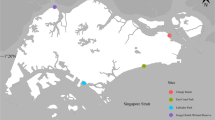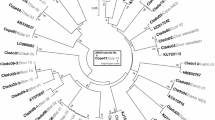Abstract
Two molecular protocols for the identification of mussel and scallop have been developed using specific primers targeting the mitochondrial 16S ribosomal DNA gene and the nuclear 18S ribosomal DNA gene. Primers for the mitochondrial 16S ribosomal DNA gene in multiplex polymerase chain reaction (PCR) protocols yielded diagnostic DNA fragments for the mussels Mytilus edulis, Mytilus galloprovincialis, and the hybrid Mytilus edulis/galloprovincialis (335 bp), the king scallop Pecten maximus (382 bp) and the black scallop Mimachlamys varia (398 bp). DNA from the queen scallop Aequipecten opercularis showed no consistent PCR amplification of the 16S rDNA gene. Primers for the nuclear 18S rDNA gene in standard PCR protocols yielded similar-sized, diagnostic DNA fragments (approx. 190 bp) for the mussels Mytilus edulis, Mytilus galloprovincialis, and the hybrid Mytilus edulis/galloprovincialis, the king scallop Pecten maximus, the black scallop Mimachlamys varia, and the queen scallop Aequipecten opercularis. Both protocols have been tested with Mytilus spp., P. maximus, and 6 other bivalve species from a wide range of locations in Irish and European waters. Cross reaction of the specific primers with DNA template from any of the 6 other bivalve species was not observed. Rapid DNA extraction using FTA Card technology and the16S rDNA primers allowed for the detection of at least 10 mussel larvae in a subsample of natural plankton.









Similar content being viewed by others
References
Ahmad M, Beardmore JA (1976). Genetic evidence that the “Padstow mussel is Mytilus galloprovincialis”. Mar Biol 35: 139–147
Beaumont AR, Zouros E (1991) Genetics of scallops. In: Shumway SE, ed. Scallops: Biology, Ecology and Aquaculture. (New York, NY: Elsevier Science B.V.), pp 585–623
Beaumont AR, Morvan C, Huelvan S, Lucas A, Ansell AD (1993) Genetics of indigenous and transplanted populations of Pecten maximus: no evidence for the existence of separate stocks. J Exp Mar Biol Ecol 169: 77–88
Beaumont AR, Turner G, Wood AR, Skibinski DOF (2004) Hybridisations between Mytilus edulis and Mytilus galloprovincialis and performance of pure species and hybrid veliger larvae at different temperatures. J Exp Mar Biol Ecol 302: 177–188
Bell JL, Grassle JP (1998) A DNA probe for identification of larvae of the commercial surf clam (Spisula solidissima). Mol Mar Biol Biotechnol 7: 127–137
Bendezu IF (2004) Detection of the tomato MI 12 gene by PCR using non-organic DNA purification. Nematropica 34: 23–30
Boore JL, Brown WM (1994) Mitochondrial genomes and the phylogeny of molluscs. Nautilus Suppl 2: 61–78
Bourne NF (2000) The potential for scallop culture—next millennium. Aquaculture Int 8: 113–122
Canapa A, Barucca M, Marinelli A, Olmo E (2000) Molecular data from the 16S rRNA gene for the phylogeny of Pectinidae (Mollusca: Bivalvia). J Mol Evol 50:93–97
Crabbe MJC (2003) A novel method for the transport and analysis of genetic material from polyps and zooxanthellae of scleractinian corals. J Biochem Bioph Meth 57: 171–176
Evans BS, White RWG, Ward RD (1998) Genetic identification of asteroid larvae from Tasmania Australia, by PCR-RFLP. Mol Ecol 7: 1077–1082
European Council (1999) Regulation N° 104/2000 of 17 December 1999 on the common organization of markets in fishery and aquaculture products. Off J of the European Communities L 17.21/01/2000, 22–52
Frischer ME, Danforth JM, Tyner LC, Leverone JR, Marelli DC, Arnold WS, Blake NJ (2000) Development of an Argopecten-specific 18S rRNA targeted genetic probe. Mar Biotechnol 2: 11–20
Frischer ME, Hansen AS, Wyllie JA, Wimbush J, Murray J, Nierzwicki-Bauer SA (2002) Specific amplification of the 18S rRNA gene as a method to detect zebra mussel (Dreissena polymorpha) larvae in plankton samples. Hydrobiologia 00: 1–11
Garland ED, Zimmer CA (2002) Techniques for the identification of bivalve larvae. Mar Ecol Prog Ser 225: 299–310
Geller JB, Carlton JT, Powers DA (1993) Interspecific and intrapopulation variation in mitochondrial ribosomal DNA sequences of Mytilus spp. (Bivalvia:Mollusca). Mol Mar Bio 2: 44–50
Hall TA (1999) BioEdit: a user-friendly biological sequence alignment editor and analysis program for Windows 95/98/NT. Nucleic Acids Symp Ser 41: 95–98
Heipel DA, Bishop JDD, Brand AR, Thorpe JP (1998) Population genetic structure of the great scallop Pecten maximus (L.) in the northern Irish Sea investigated by randomly amplified polymorphic DNA. Mar Ecol Prog Ser 162: 163–171
Heipel DA, Bishop JDD, Brand AR (1999) Mitochondrial DNA variation among open-sea and enclosed populations of the scallop Pecten maximus in western Britain. J Mar Biol Ass UK 79: 687–695
Inoue K, Herbert Waite J, Matsouka M, Odo S, Harayama S (1995) Interspecific variations in adhesive protein sequences of Mytilus edulis, M. galloprovincialis, and M. trossulus. Biol Bull 189: 370–375
Klinbunga S, Khamnamtong N, Tassanakajon A, Puanglarp N, Jarayabhand P, Yoosukh W (2003) Molecular genetic identification tools for three commercially cultured oysters (Crassostrea belcheri, Crassostrea iredalei, and Saccostrea cucullata) in Thailand. Mar Biotechnol 5: 27–36
Lindeque PK, Harris RP, Jones MB, Smerdon GR (1999) Simple molecular method to distinguish the identity of Calanus species (Copepoda:Calanoidea) at any developmental stage. Mar Biol 133: 91–96
Lopez-Pinon MJ, Insua A, Mendez J (2002) Identification of four scallop species using PCR and restriction analysis of the ribosomal DNA internal transcribed spacer region. Mar Biotechnol 4: 495–502
Martel AL, Auffrey LM, Robles CD, Honda BM (2000) Identification of settling and early postlarval stages of mussels (Mytilus spp.) from the Pacific coast of North America using prodissoconch morphology and genomic DNA. Mar Biol 137: 811–818
Meyer A (1994) Molecular phylogenetic studies of fish. In: Beaumont AR (ed.) Genetics and Evolution of Aquatic Organisms, London, UK: Chapman and Hall, pp, 219–249
Olsen RR, Runstadler JA, Kocher TD (1991) Whose larvae. Nature 351: 357–358
Paugam A, Le Pennec M, Andre-Fontaine G (2000) Immunological recognition of marine bivalve larvae from plankton samples. J Shellfish Res 19: 325–331
Paugam A, Le Pennec M, Marhic A, Andre-Fontaine G (2003) Immunological in situ determination of Pecten maximus larvae and their temporal distribution. J Mar Biol Assoc UK 83: 1083–1093
Pizzamiglio M, Mameli A, Maugeri G, Garofano L (2004) Identifying the culprit from LCN DNA obtained from saliva and sweat traces linked to two different robberies and use of a database. International Congress Series 1261: 443–445
Rogers AD (2001) Molecular ecology and identification of marine invertebrate larvae. In: Atkinson D, Thorndyke M (eds.) Environment and Animal Development: Genes, Life Histories and Plasticity. (Oxford, UK: BIOS Scientific Publishers)
Schaar CG, Boets EPM, Ronday HK, Breedveld FC (1997) Disseminated thrombosis, an unusual and catastrophic manifestation of the antiphospholipid syndrome. Neth J Med 50, A10–A11
Seed R (1968) Factors influencing shell shape in the mussel Mytilus edulis. J Mar Biol Ass UK 48: 561–584
Seed R (1971) A physiological and biochemical approach to the taxonomy of Mytilus edulis L. and M. galloprovincialis Lmk. from South West England. Cah Biol Mar 12: 291
Seed R (1976) Morphological variations in Mytilus from the Irish Coasts in relation to the occurrence and distribution of M. galloprovincialis Lmk. Cah Biol Mar 15: 1
Shirasawa H, Kinoshita T, Shino Y, Mori K, Shimizu K, Simizu B (1995) Cloning and sequencing of the murine farnesyltransferase-encoding cDNA from a cell line which expresses the human papillomavirus type-16 E6 gene*1. Gene 164: 373–374
Skibinski DOF, Beardmore JA (1979) A genetic study of intergradation between Mytilis edulis and Mytilus galloprovincialis. Experientia 35: 1442–1444
Slater J (1995) Scallop spat collection in Mulroy Bay, Ireland, 1979–1994. In: Book of Abstracts, 10th International Pectinid Workshop, Cork, Ireland, 26 April–2 May, Burnell G, ed. (Cork, Ireland: University College Cork) pp, 68–69
Thompson JD, Gibson TJ, Plewniak F, Jeanmougin F, Higgins DG (1997) The CLUSTAL_X Windows interface: flexible strategies for multiple sequence alignment aided by quality analysis tools. Nucleic Acids Res 24: 4876–4882
Wilding CS, Beaumont AR, Latchford JW (1997) Mitochondrial DNA variation in the scallop Pecten maximus (L.) assessed by a PCR-RFLP method. Heredity 79: 178–189
Wilding CS, Beaumont AR, Latchford JW (1999) Are Pecten maximus and Pecten jacobaeus different species? J Mar Biol Ass UK 79: 949–952
Wood AR, Beaumont AR, Skibinski DOF, Turner G (2003) Analysis of a nuclear-DNA marker for species identification of adults and larvae in the Mytilus edulis complex. J Moll Stud 69: 61–66
Acknowledgments
The authors acknowledge the financial support provided by the H.E.A. Technological Sector Research Programme Strand III: Core Research Strength Enhancement supported by the National Development Plan 2000–2006.
Author information
Authors and Affiliations
Corresponding author
Rights and permissions
About this article
Cite this article
Bendezu, I.F., Slater, J.W. & Carney, B.F. Identification of Mytilus spp. and Pecten maximus in Irish Waters by Standard PCR of the 18S rDNA Gene and Multiplex PCR of the 16S rDNA Gene. Mar Biotechnol 7, 687–696 (2005). https://doi.org/10.1007/s10126-004-0124-y
Received:
Accepted:
Published:
Issue Date:
DOI: https://doi.org/10.1007/s10126-004-0124-y




